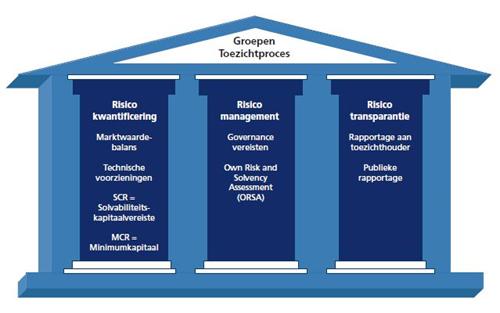"Solvency III? Over my dead body!"
He is known as the architect of Solvency II. And now that the first, major review of this European construction is coming up, Karel Van Hulle may be the first to comment. How strong is the Solvency House? Are adjustments necessary? And will there ever be another Solvency III?
The conversation takes place via Teams. Of necessity, because Belgium is locked down. Prof. Karel Van Hulle "lives and breathes digitally nowadays". Last year his book Solvency II is good for you was published, but COVID-19 ensures that he hardly gets a promotion. "Before corona, I was involved in at least thirty conferences a year. As a speaker, moderator or chairman. Now everything is digital. I miss the contact with people."
He is corona tired, but adapts to this new reality without a murmur. For example, he has been virtually traveling the world for months. "I live on the farm outside in Belgium, but besides my classes at the Catholic University of Leuven, I have nothing to look for in Belgium."
On the morning of the interview, he had a conversation with London. That same afternoon he speaks to the board of the financial regulator in Bermuda and a day later he leads a conference in Georgia. "The Georgian market would like to switch to Solvency II (hereinafter referred to as SII). This applies to more countries in Central and Eastern Europe, and in the former Soviet Union. SII is now fully or partially applicable in many places in the world. For example, in South Africa, Israel, Morocco and Algeria. And if we look at Asia: in Japan, China and Hong Kong. In Latin America in Brazil, Mexico and Chile. And finally, here in Europe, Switzerland, among others, has long embraced the principles of SII. Fortunately, supervision is risk-based everywhere. That is the essence of SII."
Who is Karel Van Hulle?

Karel Van Hulle was head of the Insurance and Pensions Department in the Directorate General Internal Market and Services from 2004 to spring 2013. After thirty years of loyal service to Europe, he gave up at the age of 61 and it was up to his successor to bring Solvency II to the market. But, as he himself once said in an interview in the Verbondsmagazine Verzekerd!, he did let go of Solvency in his position, but not from his life. In June 2019 his book Solvency II is good for you was published.
Prof. Van Hulle teaches at the Catholic University in Leuven and at the Goethe University in Frankfurt. In addition, he is a member of the Public Interest Oversight Board, an international body that oversees the auditing and ethical standards developed within the framework of the International Federation of Accountants. And finally, he is a member of the Board of the Bermuda Monetary Authority.
You are called Mister Solvency. Were you satisfied when 'your' SII finally came into force on 1 January 2016, after years of delay?
"When we put our proposal on the table in 2007, we could of course never have known that a financial crisis would break out not long after. In fact, I think it was questionable whether SII would have come about if we had submitted our proposal two years later. Insurers stated that they were not the cause of the crisis and therefore there was no need for new regulations. What a mistake! After all, it soon became clear that one of the most important consequences was a reduction in interest rates and that was just the worst thing that could happen to insurers. You also saw that all kinds of mechanisms were put in place to curb the enormous volatility. Each country began to advocate for its own SII, as it were, and that was not our idea of a European framework. So yes, I was happy when the negotiations stopped and there was finally an agreement."
As the architect of the building, are you also responsible for the three pillars that characterize SII?
"No, I didn't come up with that one. We borrowed the three pillars from the banking sector, which had already introduced a three-pillar regime in 2004, with Basel II. The sector wanted to emphasize that a good solvency regulation is a combination of a quantitative factor (capital), a qualitative (good governance and risk management) and transparency, both with reporting to the supervisory authority and the public. We took this into account in the development of SII. You can't solve everything with capital. Especially for insurers, good risk management and good governance are essential. To underline the importance of all pillars, I have made a diagram in which SII is presented as a house with three (equally large) pillars and a roof (group supervision). I have often advised insurers and students to hang this schedule above their beds, so that they never forget that solvency is not just a matter of capital."
The Solvency II House
The Solvency legislation is characterised by three pillars. The first contains the quantitative capital requirements. The second relates to risk management, governance and the ORSA (Own Risk and Solvency Assessment) and the third houses the reporting. 
The original delivery date of the house, October 2012, has been rescheduled three times. First to January 2013, then to January 2014 and finally the regulations will apply from 1 January 2016.
In addition to some small adjustments here and there, there is now a somewhat larger renovation coming up. All parties involved, including the Dutch Association of Insurers, have made their wishes known to the European Commission. Architect Karel Van Hulle expects that the renovation will not be completed until 2025 (or 2026).
Meanwhile, the world looks very different. For example, does the corona pandemic have consequences for regulations?
"The world has indeed changed quite a bit, but COVID-19 is not a real problem from an insurance perspective. There is some excess mortality, events are cancelled, etc. but all in all that is manageable. Insurers sometimes had a hard time with the volatility of the financial markets. There were also problems with whether or not the damage suffered due to business interruption is insurable, but the main problem of COVID-19 is in the operational risk. Not all insurers were equally well prepared for a digital world, where staff work from home and contacts with customers are only possible virtually. Not all insurers had also properly hedged for the security of their software against hacking. More attention should be paid to these operational risks in the regulations. Insurers will have to demonstrate that they can work virtually in a secure environment."
And what about sustainability? Europe is busy with regulations to limit CO2 emissions, among other things. Does that hit SII?
"More than COVID-19. The pandemic will disappear (preferably as soon as possible), but that does not apply to climate change and sustainability. That is why the European Commission has asked supervisor EIOPA what changes are needed in the SII structure to contribute to the climate objectives of the Green Deal and to the sustainability goals of the United Nations. EIOPA has already made a number of proposals – including a more long-term approach to assessing risks and drawing up internal models – but if you ask me, insurers can already change their policies. For example, by no longer investing in shares of polluting companies. Or by no longer providing cover to these companies. There is no reason to wait for regulation. In fact, by emphasizing good risk management, SII encourages action."
"You can't solve everything with capital"
How strong is the SII structure? Does something have to be adjusted with every breath of wind or is it rather a hefty storm needed?
"SII is not a no-failure regime. Technically, it is still possible that an insurer does not survive a hefty storm, but the capital position of most European insurers is very comfortable. COVID-19 hasn't changed that. On the contrary, both insurers and regulators want to keep the capital position as strong as possible. Sometimes even too strong. It is not necessary for the solvency ratio to be 150, 200 or sometimes even 1,000 percent. Due to regular adjustments, the building is and remains well secured. Even extreme stress tests show that a lot needs to be done before the insurance sector gets into trouble."
Nevertheless, EIOPA has proposed to increase capital requirements. Unfair?
"I agree that there is no reason to increase capital requirements now, but that is not eiopa's intention either. Their proposal states that they do not want to increase the general capital tax of insurers. I know that there are many insurers, not only in the Netherlands, who find the new requirements too high, but I think it is really too early to judge. The discussion has only just begun and, moreover, what is now on the table is 'only' a proposal from the European supervisory authority. I want to see the complete picture before I make my judgment."
Higher buffers can also lead to a higher premium. Are the buffers not high enough now?
"From the fact that insurers now hold more capital than necessary, I don't think so. The fact that they can do so proves that there are no dramatic standards. But if you're talking about the risk margin, which is actually an extra capital buffer that insurers have to maintain when calculating the technical provisions, then you're right. The risk margin is now based on six percent and that may be done away with."
What would you consider a reasonable margin?
"Between two and three percent would be realistic, but the method of calculation also needs to be adjusted. It's quite technical to explain that in detail, but it means that we have to look even more at the real risk."
"The risk margin is based on six percent. You can get rid of that"
In any case, insurers want the SII rules to take better account of the real risk of long-term products. Is that not happening enough now?
"I think that's the hardest part of the whole building. Because what is the real risk of long-term products? That presupposes that we speak out about the future, and that future is by definition unpredictable. That is precisely why we have to model that risk, but each model is relative. I hope that the review of SII will find a better way to reflect this risk. Now insurers mainly look at the market value, which leads to volatility in times of low interest rates, while they may have to pay more attention to the economic, intrinsic value. That is also the message of SII. The structure is based on an economic balance sheet and that is not necessarily a balance sheet that only looks at the fluctuations of the market."
The Association also argues for an improvement of the so-called Volatility Adjustment to better absorb these fluctuations. Does a company-specific adjustment fit in with a general framework such as SII?
"I understand that wish. When the crisis caused low interest rates in 2009, the edifice became too volatile. That is why volatility adjustment has been introduced. I have no problem with it if it becomes company-specific, but under the heading of equal monks equal hoods. If each Member State can work it out as it wishes, I think it is a problem. Then the European system becomes a national system and I don't like national sauces."
"I don't like national sauces"
If you could change one thing about SII in the context of the review. What would you do then?
"I would like the review to be used to strengthen the structure, so that insurers can better 'master' the challenges. In addition to climate change and sustainability, I also mean a risk such as cybersecurity. As far as I'm concerned, the review needs a better focus. There is now so much on the table that you can no longer see the forest for the trees. That is wrong. It is not a purely technical exercise, but a fundamental reflection on the structure itself. And that structure should help insurers to fulfil their role as professional risk managers as well as possible. This means that capital requirements must remain reasonable, in proportion to the risk incurred, and that no new rules are introduced if they are not strictly necessary. Another great wish of mine is better treatment of long-term liabilities and the associated long-term investments. Incentives should be built in to gently force insurers to take more and better account of the consequences of climate change, and of the need to build a more sustainable society."
We are still in SII. Will there be, following Basel at the banks, another SIII and maybe even an IV?
"What a wonderful final question. SII is risk-based and I wouldn't know what else to do but that. SII is superior as a structure and that makes it a sturdy structure. My answer to your question is therefore short but powerful: Over my dead body!"
(Text: Miranda de Groene, Photography: Ivar Pel)
Solvency II is good for you

Karel Van Hulle already had the title of his book, even before he started writing: Solvency II is good for you. "I've often used that title in presentations. In total, I have always concluded hundreds of lectures on Solvency with that slogan."
Basics
The reason for the title is manyfold. In this way, Van Hulle not only wanted to describe the creation, but also the significance of Solvency II in his book. "I know from experience how quickly people forget why certain rules were ever introduced. I wanted to retell the basics in such a way that everyone knows why it is the way it is. I wanted a book that clearly describes – even for a layman – what SII is, why it was introduced and what meaning it has for everyone who has to deal with it. And you guessed it: that's all of us. So SII is also good for you."
Social importance
In addition, Van Hulle wants to use the title to make clear the great social importance of insurance. "I myself only entered the insurance sector late. Actually, as it goes with (almost) everyone, that was never my intention. But once I started to delve into the sector, I was immediately touched by its social relevance."
What is insurance?
He has therefore consciously chosen to kick off his book with the chapter What is insurance? "Many publications about SII are based on a high level of knowledge and are packed with all kinds of formulas. I wanted to explain first what insurance actually is, because there are few people who understand the logic between risk and premium. And if you want to understand SII, you also need to think about the insurance product. Insurers take into account the real risks in their system. In other words, they ensure that life becomes liveable and that is good for the consumer. The only problem is that hardly anyone realizes that and insurers themselves are not good messengers. They fall into technical details too quickly."
"Moreover," van Hulle concludes, "it is sometimes better if someone else says it. SII is good for you and for me, because it enables insurers to be creative and not make promises that they cannot keep (afterwards)."
Learn More
Unlike many other books on Solvency, van Hulle's book does not contain any formula. More information: Solvency Requirements for EU Insurers: Solvency II is good for you, Intersentia, ISBN 978-1-78068-177-1. "A beautiful Christmas gift", Van Hulle concludes with a wink.
Was this article useful?
